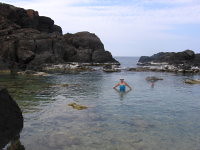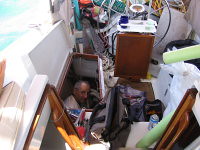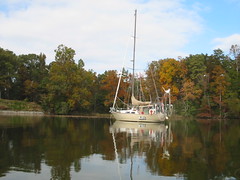Picture: Bev in the Jacuzzis, Isla de Culebrita
We were welcomed into Salinas by two boats that we had met in Luperon, Rose and Meridian Chaser. Didn't have much time with Rose, Sandra and Bill, only a quick hello and goodbye as they were off the next morning heading west. Jan and Judy on Meridian Chaser had been in Salinas for about a month and were willing to share all the info on this sailor friendly town, starting with dinner at Cruisers' Galley. New owners had taken over in the past few months, and the food was excellent and affordable -- all you could eat BBQ with salad bar for $10. We also found Roy and Wanda (the poet on Renaiance) who are staying in the marina until they leave for an family trip to Alaska in June.
Salinas harbour is surrounded by mangroves 360 deg so it is very protected. Some people use this as a hurricane hole. The harbour and the local wet lands are natural breeding grounds for Manatee and yes there are lots of them here and they are not imported. Playa Salinas has a good bakery and a great marine supply store so most of our needs can be met. Everything is close at hand except food stores and auto part stores. These are in Salinas proper a couple of miles up the road.
The westerly winds are continuing and we know we should really be taking advantage of this but still want to tour the island and get some boat things fixed. At Playa Salinas Marine we were able to get a bracket to replace one that broke off the boom (for the main sheet) and have a new topping lift made. Our old one, made of stainless steel aircraft cable was unravelling. In the quiet harbour it was easy to hoist Ross up the mast to install the new one. (Thanks Jan for your backup) That took two big jobs off the list. We plan to rent a car Wednesday/Thursday to travel to the Aricebo Radio Telescope Observatory and the Rio Camuy Cave Park and reprovision along the way. We can't go earlier because the Aricebo is not open on Monday and Tuesday. We had met up with a nice young Columbian couple, Natalie and Luis, (Vagamundo) and planned to share the trip with them.
But Monday morning, our weather reports indicated that we would have a great opportunity to get to Culebra early this week, and that by the weekend the winds would be too strong to allow us to go. So we quickly changed our plans, we went shopping (still with Natalie and Luis) completely filling the rental car with all of our purchases, mostly food. It was great having Natalie and Luis along, because Spanish is their first language, and they negotiated a better price for the rental car (got a full sized car for the price of the small ones) and got us into Sam's as "visitors" something they are not usually willing to do.
We returned to the Marina in Salinas, quickly dinghied our purchases to RAFT, put the refrigerator stuff in the refrigerator, and then went to have drinks with Roy and Wanda, and farewell dinner again at the Cruisers' Galley Upon our return to RAFT, we still had to store all our purchases away and get ready to take off in the morning.
We had a wonderful sail to Vieques. The seas are calm and the winds not quite strong enough for us to turn off the engine, but it is still a wonderful day to be on the ocean. We anchored carefully off Green Beach, having dragged through the grassy area to the sand, but the anchor held before it reached the coral ledge. Bev dove to check the anchor and enjoy the fish swimming under RAFT. This is only the second time since we left Georgetown that we have been able to enjoy the water.
When we arrived, there was one powerboat there, and he left, leaving us the entire anchorage to ourselves. When this happens we are always concerned that maybe we misread the weather, or charts and question whether we should stay. But we had a very quiet night, and had no difficulty getting the anchor up in the morning.
The winds were still forecast to be light so headed to a little bay on the east end Viaques, Baie Icacos. The US Navy used Veiques as a NATO bombing range for the last 40 years. We have heard that the the bombing range been closed in the last two years and that with permission you can anchor in the little bays BUT DON'T TOUCH ANYTHING!! We call the range control to request permission and got no answer. Procedure then is if you get no answer than it is okay to go. We were entering the anchorage when the range control called to inform us that we had to leave the area immediately as the range was "HOT" and that we were in the "fragmentation fallout area". Don't your just love military terms. Appears that they are in the process of cleaning up the range and disposing of unexploded ordinance. This caused us to alter course to Culebra which was our ultimate destination.
We decided to take advantage of the light winds and anchor on the north side of Culebrita. As promised by the guide books, this is a fantastic anchorage as long as there are no northerly swells. We picked up the last mooring ball (free) and started to explore the island. First stop: the Jacuzzi's Here there several ponds, somewhat cut off from the ocean, that trap fish, and the dark rocks absorb the sun's heat and transfer it to the water. It was really lovely. Can't compare it to the Baths in Virgin Gorda as we haven't been there, yet!
The next day we hiked to the lighthouse, 305' above sea level and view was magnificent. We also checked out the other 2 beaches that are on the island. The snorkeling, right off the boat was fantastic. Bev saw reef squid, a school of blue tangs, stoplight parrot fish, and all the other usual reef fish, plus was able to follow a seaturtle for quite a distance, close enough to see the 3 yellow remoras underneath the turtle. That evening when we disposed of some salad leftovers overboard, 3 reef sharks were fighting for the remains. You could easily spend a week in the anchorage, except as the wind started to pick up, the swell caused RAFT to rock from side to side. Guess our time in this beautiful anchorage was coming to an end.
So we motored over to Ensanada Honda, and anchored behind Cayo Pirata, just off the small town of Dewey. We will hang around the Spanish Virgins for the next 3 weeks or so. We will try to use this as a base of operations and take the ferry back to Puerto Rico for some day trips. Hopefully will get to the Radio Telescope and the caves. This is a very protected bay that we can leave RAFT. It is also the local hurricane hole for the charter fleet stationed in St Thomas and St John. Culebra is still considered to be part of Puerto Rico and has regular ferry service between San Juan and Fajardo.
Just as a note: If you are using winlink for emails, the southern coast of Puerto Rico is terrible for transmission. things have improved now that we are in the Spanish Virgins.



